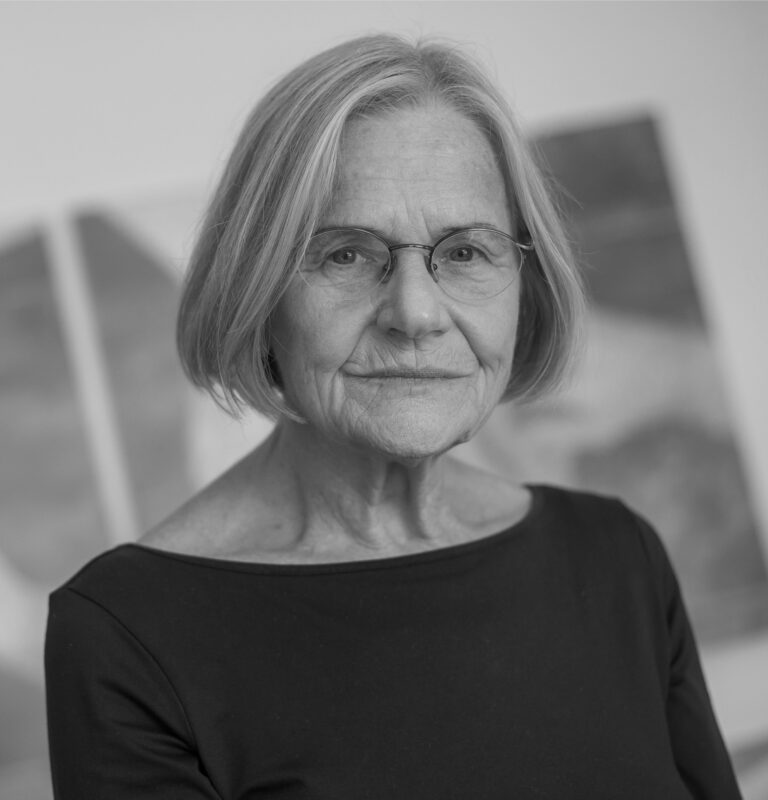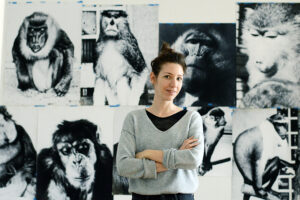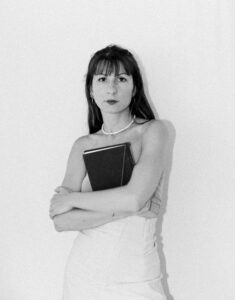Ilona Lovas

– born in 1946, died in 2021, a Kossuth-prize winning Hungarian textile artist. She graduated from the weaving department of the Hungarian University of Applied Arts in 1974. She earned her DLA degree in 2002 and habilitated in 2004. Between 1987 and 1989 she lived in New York City. The beginning of her career coincided with the establishment of the Textile Art Workshop in Velem, Hungary, of which she was one of the first participants. The aim of the workshop was to renew the genre of textile art. From the 1980s the conceptual style and the use of soft materials became characteristic of her works, while she was among the first artists in the Hungarian art scene who applied the female point of view in her works. She is intrigued by finding a direct relation to nature and working with organic materials. She is interested in questions of history and the personal and collective memory, from a consistent worldview of a God seeker. Each of her works is a prayer for the vulnerable. Her materials, forms and objects are only serving her ideas. Searching for connection with transcendence has become a defining feature of her works. Beyond constantly experimenting with materials, the media of installation, video and performance play a significant role in her artistic practice.
The experimental Textile Art Workshop was founded in 1975, in a small village called Velem, in Vas county, the Western part of Hungary. As a freshly graduated textile student, I had the opportunity to work here. This start was significant in the further development of my career. The workshop aimed to renew the genre of textile art. It was possible to do so, as the activity of the workshop was beyond the focus of socialist political power. The female point of view was not declared in its program – though the core of the workshop was formed by women – only experimenting with new materials and techniques (for me these were the organic materials, handmade paper then later line and glass fibre). In addition, we started to create our own identity instinctively. Due to the general lack of information, without theoretical knowledge, we formulated similar problems to our Western colleagues, while working with consciously used, traditional female textile techniques as well.
I started to move away from experimental textile art in 1980, with my installation called Island1, exhibited at the Pécs Gallery. I presented the experience of attacking people in connection with the shocking events of the Russian-Afghan war that was taking place at the time, and which was often in the news. I built an island covered with white canvas, surrounded by water. Life-size people were painted on the canvas. The visitors of the exhibition had to cross these bodies in order to move in the space.
In 1984 I had the opportunity to realize a solo show in Kőszeg, a small town in Western Hungary, as I won the Biennial of Tapestry and Textile Art in Szombathely. From this exhibition onwards, I call my works Station, numbering them in chronological order, until 2000. I created seven installations made of cellulose panels, supported with metal grids2. I put texts written on silk in them, I sowed wheat in the cellulose, which sprouted. With the rusting wire I wanted to depict the notion of passing. This installation was the first step in finding my own path.
I developed the idea of my exhibition in Kőszeg at the textile art shows I participated at the Arts Décoratifs in Paris, at the Künstlerhaus in Graz3 and at Helikon Gallery as well, where I arranged psalms and my own texts written in columns on silk. As the sowed wheat was growing, it always dropped a layer of paper and the hidden text became more and more visible. I presented the 30 m long version of this work – as a quasi-roll of the Bible – at the International Triennial of Tapestry in Łódź4.
Then, because of the work of my husband, architect Tamás Nagy, we spent three years in New York City, which was a very important period in the development of my artistic vision. I collaborated with Sandra Gering Gallery in New York. When we returned to Hungary, the regime change had already taken place and brought a lot of tension. At the time I still had an ongoing invitation to the Art in General Gallery, but I knew that I had to deal with all the problems at home. In this process I have explored beef intestines, the material that made me able to show all the things that happen inside a person, and all the imprints and damages made by frustration. I am glad that I studied at the University of Applied Arts because I was never afraid of experimenting with materials – including the “cheap” and “inferior” ones.
For this exhibition I made a huge drum, which is traditionally used for connecting dimensions5. Moving forward with this idea, but using the same material I created the first Spools6 that got exhibited worldwide. I call them soul seeds, but most often, babies: first of all, I create the form that I cover with intestines, and then I caress them as if there were children or souls inside them.
It was important for me that I transfer a disgusting material, the intestines, into an ethereal quality of beauty. My work called Station No. 28 was realized as part of the series of exhibitions titled Trial by Water7, which was an attempt to represent the waves of art by women in the 1990s. I made a 12 m long metal table for this show and I placed metal and glass trays to accommodate the altar bread (wafers) and loaves of bread baked by me.
At that time some leftover wafers were on my table for a long time. The wafers were made by nuns who cut circles from the bread which will be sanctified and used in the church during the mass. A perforated circle of diameter 30 cm remained. In this work I was interested in the meaning of the missing holes and how they can be filled. From this time, wafer became a part of my work as a material.
Instead of all the fears and doubts in life, I focused on the potential of healing in my 1997 installation entitled Station 328. I recalled the pain of self-sacrifice and giving birth through stitches, needles, rust, concentrated lights and operating tables, showing the fourteen stations of the multi layered beef tripe, stretched on glass. I tried to reproduce the original, sacred function of the Wendelinskapelle9 in Stuttgart. I placed ten glass benches in the space, engraved on them the Ten Commandments, and placed wafers on their surface, beneath them were steel plates as carpets. On the wall there was a video, like an altarpiece, in which I washed the guts in the constantly flowing, clean water.
My series called Innocenti10 was based on a war incident against children. I enlarged my photos about the medallions of the Ospedale degli Innocenti, and used them as press images. I placed wafers on them, and covered them with clean, white, soft intestines to protect them.
In the early 1990s I came across my grandfather’s letters he wrote to his family from the front of World War I. Shortly after he returned home, he died and left behind three orphans, a wife and a prosperous hat factory (he delivered hats in the whole Austro-Hungarian Empire).
I inherited his letters and the models of the hats, which I use in my works that deal with their sufferings. In my first video installation titled Have Mercy on Me11, I say a monotonous prayer for them, in the framework of a pilgrimage, where the models of the hats are impersonated. In my video titled S.O.S.12 I presented the hat models floating in the sea. In this work, I expanded the Christian point of view, the horizon of forgetfulness and forgiveness and completed it with statements that are valid in all religions. I made imprints of the models as well, that I used in my video Anima Nostra: I walk among them, as if they were dead souls13.
I never wanted to live up to the ideals of men, it was always in my mind that I am a woman. For me it is a very favourable situation. I can work with the things that “put” me together, and this includes the role of being a mother. The art scene finds it hard to accept that artists – especially women – have a private life or a family. When I was teaching the most important aspect was to increase the self-confidence of my students, as most of them were women. Living in New York I followed the feminist movements and I agreed with the actions of the Guerilla Girls who fought for the representation of women in art that was undeservedly low at that time. In 1978 I was also an active participant of fighting for the equality of women. That is how I took part in the first Feminist Conference in Belgrade together with Orsolya Drozdik and Judit Kele, where we exhibited a series of photographs about ourselves in which we appeared in typical female roles. This collaboration did not last long because of the different ways of our lives.
The final version of this statement was created in collaboration with art historian Kata Balázs (2021).
Kata Balázs is an art historian living in Budapest. She graduated from both departments of Hungarian and Art History studies at ELTE University in Budapest. Since 2007, she has conceived and contributed to numerous publications mainly focusing on avant-garde and neo-avant-garde art, held a teaching position at the University of Theater and Film Arts in Budapest, the Visart Academy of Arts, the Károly Eszterházy University of Eger, worked at Ludwig Museum Budapest and as a young research fellow at the Art History Research Institute of the Hungarian Academy of Sciences. In 2020, she joined acb ResearchLab as researcher.
1Image: Ilona Lovas, Island, space installation at the Pécs Theater Gallery, 1980, screened fabric, grass, water, 300 x 2400 cm. Courtesy of the artist.2Image: Ilona Lovas: Station No1, installation at the Zwinger in Kőszeg, 1984, 7 pieces of hand-made paper board, metal mesh, wheat, 220x180 cm. Courtesy of the artist.
3Image: Ilona Lovas, Station No7 at Künstlerhaus Graz, 1986, seven cast cellulose boards, 420 x 350 cm each. Courtesy of the artist.
4Image: Ilona Lovas, Complaint wall at Centralne Muzeum Włókiennictwa, Łódź, 1985, cast paper, metal mesh, 220 x 3000 cm. Courtesy of the artist.
5Image: Ilona Lovas, Station No12, at Art in General, NY, 1990, beef intestines installation, variable size. Courtesy of the artist.
6Image: Ilona Lovas, Spools at Kisgaléria Pécs, 1992, beef intestines installation, variable size. Courtesy of the artist.
7Image: Ilona Lovas, Station 28 at Óbudai Társaskör, Budapest, 1995, glass, intestines, altar bread, metal table, 420 x 120 cm. Courtesy of the artist.
8Image: Ilona Lovas, Station 32 at King St Stephen Museum, Székesfehérvár, 1997, 42 glass plates covered with beef intestines, 120 x 80 cm each. Courtesy of the artist.
9Image: Ilona Lovas, Zehn at Stuttgart Wendelinskapelle, 2002, video installation, variable size. Courtesy of the artist.
10Image: Ilona Lovas, Innocenti at Dingenthal Stuttgart, 2002, computer print, glass, intestines, altar bread, 68 x 60 cm. Courtesy of the artist.
11Image: Ilona Lovas, Kyrie Eleison at Dunaújváros Institute of Contemporary Art, 2003, performance. Courtesy of the artist.
12Image: Ilona Lovas, S.O.S., 2006, video installation, dimensions variable. Courtesy of the artist.
13Image: Ilona Lovas, ANIMA NOSTRA at Musée de Bibracte, 2007, video installation, 9’. Courtesy of the artist.
– szül. 1946, Kossuth-díjas magyar textilművész, képzőművész. 1974-ben szerzett diplomát a Magyar Iparművészeti Főiskola szövő szakán. 2002-ben DLA fokozatot szerzett, 2004-ben habilitált. 1987 és 1989 között New Yorkban élt. Pályájának indulása egybeesett a Velemi Textilművészeti Műhely létrejöttével, amelynek egyik első résztvevője volt. A műhely célul tűzte ki a textil műfajának megújítását. A nyolcvanas évektől a konceptuális hangvétel és a „lágy” anyagok alkalmazása vált jellemzővé az alkotásaiban, miközben a magyar művészeti életben az elsők között érvényesítette a „női nézőpontot” az alkotásaiban. A természettel keresett közvetlen kapcsolat, az organikus anyagokkal való munka, valamint a történelem és az (egyéni illetve kollektív) emlékezet kérdései foglalkoztatják, egy istenkereső konzekvens világlátásból. Minden műve egy-egy könyörgés, egy-egy ima a kiszolgáltatottakért. Anyagai, formái, tárgyai és eszközei mindig csak szolgálói a gondolatainak. A transzcendenciával való kapcsolat lehetőségeinek keresése alkotásainak meghatározó vonásává vált. Az anyagokkal való folyamatos kísérletezés, az installáció mellett a videó és a performance műfaja is meghatározó szerepet tölt be a pályáján.
1975-ben alakult meg a Kísérleti textilműhely egy Vas megyei kis faluban, Velemben. Frissen végzettként szerencsém volt részt venni a munkájában. Ez az indulás meghatározó volt pályám további alakulásában. A műhely a textilműfaj újrafogalmazását tűzte ki célul. Megtehette, „szabad utat” kaphatott, mert kívül esett a politikai hatalom célkeresztjén. A programban a női nézőpont – bár főleg nők alkották a műhely magját – ugyan nem volt megemlítve, csak az új anyagokkal, technikákkal való kísérletezés (nálam a szerves anyagok, merített papír, majd a damil, üvegszál vált jellemzővé), de mindezek mellett ösztönösen elkezdtünk a saját identitásunk megfogalmazásával foglalkozni. Az általános információhiánynak köszönhetően elméleti háttértudás nélkül hasonló problémákat fogalmaztunk meg, mint „nyugati” társaink, élve a tudatosan használt hagyományos női technikákkal is.
A kísérleti textiltől való elmozdulásom 1980-ban a Pécsi Galériában a Sziget c. installációmmal kezdődött1.Az embereken való átgázolás élményét jelenítettem meg az akkor épp zajló orosz–afgán háború megrázó eseményeinek kapcsán, amelyről bőven kaptunk híradást. Egy fehér vászonnal letakart szigetet építettem, melyet víz vett körül. A vászonra életnagyságú emberek voltak felfestve. A kiállítás látogatóinak ezeken a testeken kellett áthaladniuk.
1984-ben kaptam lehetőséget önálló kiállítás rendezésére Kőszegen, mivel megnyertem az előző Szombathelyi Fal-és Tértextil Biennálét. Ettől a kiállítástól kezdve nevezem a munkáimat Stációnak, időrendi sorrendben számmal ellátva őket, egészen 2000-ig. Itt hét, fémráccsal megerősített cellulózpanelből álló installációt készítettem2. Bennük selyemre írt szövegeket helyeztem el, a cellulózba búzát vetettem, ami kihajtott. A drót helyenként előidézett rozsdásodásával az elmúlást is érzékeltetni szerettem volna. Ez az együttes az akkori útkeresésem első állomása volt.
A párizsi Arts Décoratifs-ban rendezett kísérleti textilművészeti kiállításon, illetve a grazi Künstlerhausban3 is a kőszegi munkám gondolatiságát vittem tovább, ahogy a Helikon Galériában is, ahol selyemre írva, oszlopokba rendeztem zsoltárszövegeket, illetve saját írásaimat. Ahogy nőtt az elvetett búza, mindig ledobott egy papírréteget, és egyre olvashatóbb lett az elrejtett szöveg.
Ennek egy 30 méter hosszú változatát, a Panaszfalat – mint kvázi bibliatekercset – a łódźi Textil Triennálén mutattam be 1985-ben4.
Ezután férjem, Nagy Tamás révén három évet New Yorkban töltöttünk, ami látásmódom alakulását illetően nagyon fontos időszak volt. Lehetőségem volt dolgozni, és együttműködtem a New York-i Sandra Gering Galériával. Amikor hazatértünk Magyarországra, már zajlott a rendszerváltás, ami rengeteg feszültséget hozott magával. Ekkor még volt egy folyamatban lévő meghívásom az Art in General galériába, és tudtam, hogy már csakis az itthoni problémákkal kell foglalkoznom. Ebben a keresésben találtam rá a marhabélre, amely révén meg tudtam mutatni, mi az, ami az emberben zajlik odabent, minden egyes frusztráció milyen lenyomatokat, elváltozásokat hoz létre. Hálás vagyok, hogy az Iparon végeztem, mert sosem féltem az anyagokkal – beleértve az „alantasokat” is – való kísérletezéstől.
Így erre a kiállításra egy hatalmas „dobot” készítettem, ami hagyományosan a dimenziók közötti kapcsolatteremtésre használatos5. Innen továbblépve, még ugyanezt az anyagot használva készítettem az Orsókat6, amelyek bejárták a világot. Lélekmagoknak, de a leggyakrabban babáknak hívom őket: először elkészítettem a formát, amit mosott bélszalagokkal tekerek körbe, simogatva őket, mintha valóban gyerek vagy lélek lenne bennük.
Fontos volt számomra, hogy a belet, ezt a gusztustalan alapanyagot éteri minőségbe, „szépségbe” vigyem át. A Stáció No. 28 munkám a Vízpróba kiállítássorozat részeként valósult meg7, amely helyzetképet próbált adni a kilencvenes évek nőművészeti hullámairól. Erre a kiállításra 12m hosszú fém asztalt készítettem, amelyen fém- és üvegtepsiket helyeztem el az ostyák és az általam sütött kenyerek befogadására. Ekkoriban már jó ideje az asztalomon állt egy adag ostyamaradék. Ezeket apácák készítik, és vágják ki belőle azokat a korongokat, amelyeket aztán felszentelve szertartáskor használnak. Marad utána egy perforált, 30 centiméter átmérőjű kör. Ebben a munkámban arra kerestem a választ, hogy mit jelentenek a hiányzó lyukak és mivel lehet azokat betölteni. Az ostya mint anyag innentől került be a munkáimba.
1997-ben a Stáció 328 installációmban helyeztem előtérbe a félelmek, kétségek ellenére a gyógyító gesztust, az önfeláldozás, a szülés és teremtés fájdalmait varratok, tűk, vérrozsda, koncentrált fények, üveg műtőasztalok megidézésével, három rétegben egymásra helyezett üvegre kifeszített marhabél 14 stációjában. A stuttgarti Wendelinskapellének9 igyekeztem visszaadni a tér eredeti, szakrális funkcióját: tíz üvegpadot helyeztem el a térben, rájuk vésve a tízparancsolatot, és ostyákat helyeztem a felületükre, alájuk szőnyeg gyanánt acéllemezek kerültek. A falon egy videó futott, oltárképként, amelyen az állandóan folyó tiszta vízben hófehérré mostam, mostam és mostam a beleket. Az Innocenti c. sorozatom10 kiindulópontjául egy gyerekek ellen elkövetett háborús esemény szolgált. Itt az Ospedale degli Innocenti medallionjairól készített fotóimat vettem elő, amelyeket sajtóképként használva felnagyítottam, és ostyákat helyeztem rájuk, majd védelmezőn újra körbeöleltem, bepólyáltam őket fehérre mosott, puha bélhártyával.
A kilencvenes évek elején eljutottak hozzám nagyapám levelei, amelyeket az első világháborús frontról írt a családjának. Nem sokkal azután, hogy hazatért, meghalt, és hátrahagyott három árvát, feleséget és egy jól menő kalapüzemet (a Monarchia egészébe szállított kalapokat). A levelekkel kalaptompokat is kaptam örökségül, ezeket használtam fel és még ma is használom a munkáimban, amelyekben felidéztem és feldolgoztam a szenvedéseiket. Az első, Könyörülj Rajtam c. videóinstallációmban11 monoton, vég nélküli imát mondok értük — és így magamért is — egy zarándoklat keretében, megszemélyesítve a kalaptompokat. Nem megválva a kalapformáktól, az S.O.S.12 c. videómban a tengerben úsztattam meg őket, a keresztény nézőpontot kiszélesítve, a felejtés és megbocsájtás horizontján, minden vallásra igaz állításokkal. Lenyomatot is készítettem róluk, amiket különbözőképpen használtam, például az Anima Nostra13 c. videóban köztük lépkedek, mint holt lelkek között.
Soha nem akartam megfelelni férfiideáknak, mindig szem előtt tartottam, hogy nő vagyok. Számomra ez egy nagyon jó állapot. Azzal tudok foglalkozni, ami engem „rak” össze, és ebbe a családanya szerep is beletartozik; a művészeti élet nehezen fogadja el, hogy a művészeknek – különösen a nőknek – van magánéletük, családjuk. Amikor tanítottam, az egyik legfontosabb szempontom volt a hallgatók önbizalmának a megemelése, különös tekintettel a lányokra, hisz majdnem csak lány növendékeim voltak. New Yorkban élve közelről követhettem a feminista mozgalmakat, és egyetértettem a Guerrilla Girls akcióival, akik harcoltak a művészeti életben a méltatlanul alacsony női reprezentáció miatt. Ugyan ’78-ban még én is aktív részvevője voltam a női elismertség kivívásának. Így vettem részt Drozdik Orsolyával és Kele Judittal a belgrádi Feminista Kongresszuson, ahol egy vetített képekből álló, jellegzetes női szerepekben megjelenő, magunkról készült fotósorozatot mutattunk be. Ez a közös munka a különböző élethelyzeteink miatt nem tartott sokáig.
A statement végleges formában Balázs Kata művészettörténésszel együttműködésben született (2021).
1Kép: Lovas Ilona, Sziget, Pécsi Színháztéri Galéria, 1980, térinstalláció, szitázott szövet, fű, víz, 300 x 2400 cm. A művész jóvoltából.2Kép: Lovas Ilona, Stáció No1, Kőszeg, Zwinger, 1984, installáció, 7db öntött papírtábla, fémháló, búza, 220 x 180 cm. A művész jóvoltából.
3Kép: Lovas Ilona, Stáció No7, Künstlerhaus Graz, 1986, hét db öntött cellulóz tábla, 420x350 cm egyenként. A művész jóvoltából.
4Kép: Lovas Ilona, Panaszfal, Centralne Muzeum Włókiennictwa, Łodź, 1985, öntött papír, fémháló, 220 x 3000 cm. A művész jóvoltából.
5Kép: Lovas Ilona, Stáció No12, Art in General, NY, 1990, marhabél installáció, változó méret. A művész jóvoltából.
6Kép: Lovas Ilona, Orsók, Kisgaléria Pécs, 1992, marhabél installáció, változó méret. A művész jóvoltából.
7Kép: Lovas Ilona, Stáció No28, Óbudai Társaskör, 1995, üveg, bél, ostya, fémasztal, 420x120 cm. A művész jóvoltából.
8Kép: Lovas Ilona, Stáció No32, Szent István Király Múzeum, Székesfehérvár, 1997, 42 db marhabéllel borított üvegtábla, 120 x 80 cm egyenként. A művész jóvoltából.
9Kép: Lovas Ilona, Zehn, Stuttgart Wendelinskapelle, 2002, videoinstalláció, változó méret. A művész jóvoltából.
10Kép: Lovas Ilona, Innocenti, Dingenthal Stuttgart, 2002, számítógépes nyomat, üveg, bélhártya, ostya, 68 x 60 cm. A művész jóvoltából.
11Kép: Lovas Ilona, Kyrie Eleison, Dunaújváros Kortárs Művészeti Intézet, 2003, performansz. A művész jóvoltából.
12Kép: Lovas Ilona, S.O.S., 2006, videoinstalláció, változó méret. A művész jóvoltából.
13Kép: Lovas Ilona, ANIMA NOSTRA, Musée de Bibracte, 2007, videoinstalláció, 9’. A művész jóvoltából.



